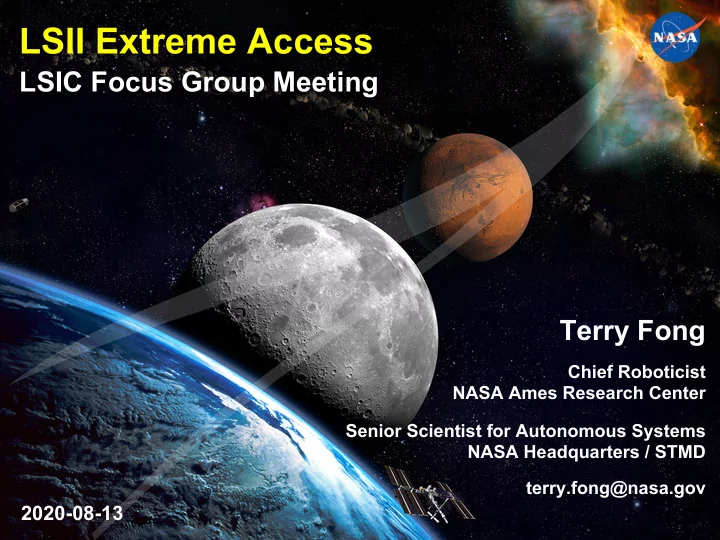

LSII Extreme Access LSIC Focus Group Meeting Terry Fong Chief Roboticist NASA Ames Research Center Senior Scientist for Autonomous Systems NASA Headquarters / STMD terry.fong@nasa.gov 2020-08-13 LSII Extreme Access 1
Extreme Access Objective • Enable humans and robots to efficiently access, navigate, and explore extreme lunar surface or subsurface environments. Considerations • An environment is “extreme” due to various factors • Extreme access may require handling one (or more) factors • Extreme access may involve a combination of mission design, mission risk tolerance, mission operations, and technology • Extreme access may be a functional capability at the subsystem or system level • Extreme access may require the integration of multiple technologies LSII Extreme Access 2
Extreme Factors Terrain • Composition (granular, friable, etc) • Geometric hazards (positive & negative scale, distribution, etc) • Slope, roughness, etc. Dust • Abrasiveness, electrostatic, etc. Thermal • High/low extremes • Cycling, gradient, etc. Radiation • Total dose • Flux Visibility • Sun (for solar illumination) • Sky (for thermal radiation, navigation, etc) LSII Extreme Access 3
Extreme Access Missions Missions • Sample return from South Pole Aitken Basin • Volatile prospecting (in PSRs) • ISRU: oxygen reduction, volatile recovery • Exploration of subsurface voids • Long duration and long range traverse (e.g., New Frontiers “Intrepid”) Targets • Steep and deep craters, gullies, scarps, canyons, crevasses, vents, pits, lava tubes • Areas dominated by “fluffy” or highly porous regolith, soft friable terrains • Locations with largely unknown terra- mechanical properties at the scale of platform • Permanently shadowed regions LSII Extreme Access 4
Technology Challenges Mobility • Enable robust, sustained surface activities (bulk transport of regolith, 1000 km scale traverses, etc.) • Enable sampling of South Pole Aitken Basin • Enable extended operations in permanently shadowed regions (more than VIPER) • Enable ingress, exploration, and egress of subsurface voids Navigation • Enable navigation with minimal infrastructure (surface or orbital) • Enable hazard detection in all lunar environments and conditions • Enable localization better than VIPER with similar (or reduced) size/ weight/power/cost (SWaP-C) • Enable autonomous operations (local area / worksite and “cross country”) Many other areas (avionics, dust, power, thermal, etc.) LSII Extreme Access 5
NASA Extreme Access R&D Game • Cooperative Auton. Distributed • Lightweight Surface • Day/Night Lunar Rover Auto Obs. Changing Robotic Explorers – TRL 8 Manipulation System – TRL 6 Avoid. & Localization – TRL 5 Development • High TRL Rover LIDAR – TRL 8 • Micro Video Guidance System • Extreme Terrain Access for Lunar Program ¡ • TP-CubeRover [Astrobotic] – TRL 8 – TRL 6 Exploration Assessment NIAC Program ¡ • Phase III – Robotic Technologies Enabling the Exploration of Lunar Pits [Carnegie Mellon/Astrobotic] – TRL 5 • Phase II Seq. – Rover Slip Est. & Traction Control for Optimal Mobility in Lunar Env. [ProtoInnovations] – TRL 7 • Phase II – CubeRover for Lunar Science and Exploration [Astrobotic] – TRL 5 • Phase I – Dynamically Reconfig. SW & Mobility Arch. for Auton. Planetary Rovers [ProtoInnovations,] – TRL 4 • Phase I – Integrating Robot Operating System (ROS) 2 with the Core Flight System [TRAClabs] – TRL 4 SBIR / STTR ¡ • Phase I – Magnetic Gearing Applications for Space [US Hybrid Corporation] – TRL 4 • Phase I – PLUMMRS: A collection of Plan Ledgers and Unified Maps for Multi-Robot Safety [TRACLabs] – TRL 4 • Phase I – Robust Vis. Perception Tech. for Intel. & Adaptive Space Robotics [Edge Case Research] – TRL 4 • Phase I – Modeling Rover Interactions with Lunar Regolith in Permanently Shadowed Regions [Blueshift] – TRL 3 • Assemblers – TRL 3-4 • Kin. Nav. & Cartography Knapsack (KNaCK) – TRL 3-4 Early Career ¡ • Joint Aug. Reality Visual Info. Sys. – TRL 3-4 • Multifunctional Sensor Platform Enabled by AM – TRL 3-4 • Burrowing Robot for Extraterrestrial Soil Sampling and Anchoring [UC Santa Barbara] – TRL 3 Space Tech • Non-Contact Eddy Current Manipulation in Microgravity Environments [Cornell University] – TRL 3 Research • Traction Optimization of a Planetary Rover via Control of a Flywheel Energy Storage [UC Berkeley] – TRL 3 Grants ¡ • Early Career Faculty 2020 – Coordinated Multi-Robots for Planetary Exploration • NASA Breakthrough, Innovative, and Game-changing (BIG) Idea Challenge – Systems and technologies to Challenges explore and operate in lunar Permanently Shadowed Regions – TRL 2-3 ¡ • Space Robotics Centennial Challenge Phase 2 – TRL 2-3 • NASA Tournament Lab – Miniaturized Payloads for Small Rovers Ideation Challenge – TRL 2-3 Center Invest ¡ • Neuromorphic Learning for Adaptive Control – TRL 1-2 LSII Extreme Access 6
Closing Thoughts Missions • Focus on “high-priority” missions (from various stakeholders) • Also consider bolder, more ambitious missions to help push technology Technology • “Pull” – Develop requirements (user needs) from proposed lunar missions and/or design references missions • “Push” – Propose new capabilities that will enable new types of missions, new science, new opportunities Not just NASA • How to close the gap between terrestrial SOA and space SOA? • How to sustain and leverage commercial space (CLPS vendors interested in mobility services)? • How to mature new technology & missions at a faster pace? LSII Extreme Access 7
Recommend
More recommend